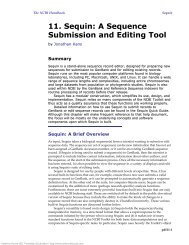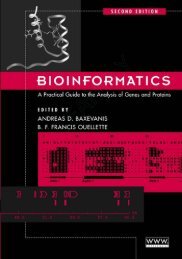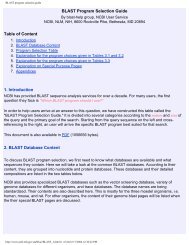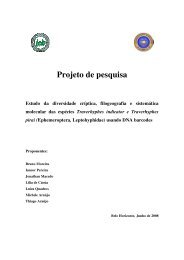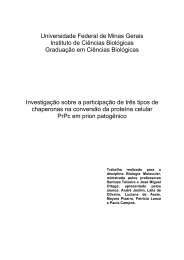1. GenBank: The Nucleotide Sequence Database
1. GenBank: The Nucleotide Sequence Database
1. GenBank: The Nucleotide Sequence Database
Create successful ePaper yourself
Turn your PDF publications into a flip-book with our unique Google optimized e-Paper software.
Antenna House XSL Formatter (Evaluation) http://www.antennahouse.com<br />
<strong>The</strong> NCBI Handbook<br />
<strong>GenBank</strong><br />
<strong>GenBank</strong> annotation staff must also respond to email inquiries that arrive at the rate<br />
of approximately 200 per day. <strong>The</strong>se exchanges address a range of topics including:<br />
• updates to existing <strong>GenBank</strong> records, such as new annotation or sequence changes<br />
• problem resolution during the indexing phase<br />
• requests for release of the submitter's sequence data or an extension of the hold<br />
date<br />
• requests for release of sequences that have been published but are not yet<br />
available in <strong>GenBank</strong><br />
• lists of Accession numbers that are due to appear in upcoming issues of a<br />
publisher's journals<br />
• reports of potential annotation problems with entries in the public database<br />
• requests for information on how to submit data to <strong>GenBank</strong><br />
One annotator is responsible for handling all email received in a 24-hour period, and<br />
all messages must be acted upon and replied to in a timely fashion. Replies to previous<br />
emails are forwarded to the appropriate annotator.<br />
Processing Tools<br />
<strong>The</strong> annotation staff uses a variety of tools to process and update sequence submissions.<br />
<strong>Sequence</strong> records are edited with Sequin, which allows staff to annotate large sets of<br />
records by global editing rather than changing each record individually. This is truly a<br />
time saver because more than 100 entries can be edited in a single step (see Chapter 11 on<br />
Sequin for more details). Records are stored in a database that is accessed through a<br />
queue management tool that automates some of the processing steps, such as looking up<br />
taxonomy and PubMed data, starting BLAST jobs, and running automatic validation<br />
checks. Hence, when an annotator is ready to start working on an entry, all of this<br />
information is ready to view. In addition, all of the correspondence between <strong>GenBank</strong><br />
staff and the submitter is stored with the entry. For updates to entries already present in<br />
the public database, the live version of the entry is retrieved from ID, and after making<br />
changes, the annotator loads the entry back into the public database. This entry is<br />
available to the public immediately after loading.<br />
Microbial Genomes<br />
<strong>The</strong> <strong>GenBank</strong> direct submissions group has processed more than 50 complete microbial<br />
genomes since 1996. <strong>The</strong>se genomes are relatively small in size compared with their<br />
eukaryotic counterparts, ranging from five hundred thousand to five million bases.<br />
Nonetheless, these genomes can contain thousands of genes, coding regions, and<br />
structural RNAs; therefore, processing and presenting them correctly is a challenge.<br />
Currently, the DDBJ/EMBL/<strong>GenBank</strong> <strong>Nucleotide</strong> <strong>Sequence</strong> <strong>Database</strong> Collaboration has a<br />
350-kilobase (kb) upper size limit for sequence entries. Because a complete bacterial<br />
genome is larger than this arbitrary limit, it must be split into pieces. <strong>GenBank</strong> routinely<br />
splits complete microbial genomes into 10-kb pieces with a 60-bp overlap between pieces.<br />
Each piece contains approximately 10 genes. A CON entry, containing instructions on<br />
how to put the pieces back together, is also made. <strong>The</strong> CON entry contains descriptor<br />
information, such as source organism and references, as well as a join statement<br />
providing explicit instructions on how to generate the complete genome from the pieces.<br />
<strong>The</strong> Accession number assigned to the CON record is also added as a secondary<br />
Accession number on each of the pieces that make up the complete genome (see Figure 2).<br />
pdf1-9




